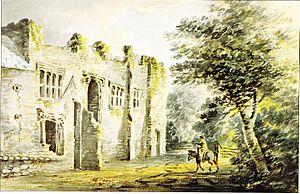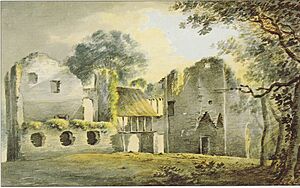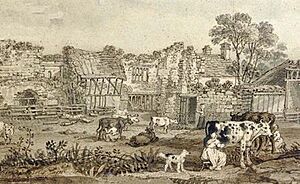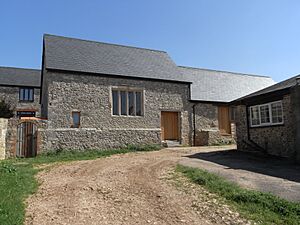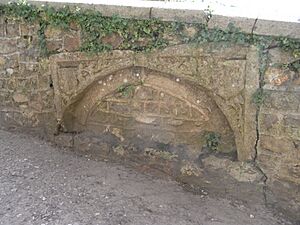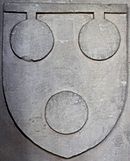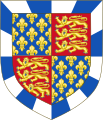Colcombe Castle facts for kids
Colcombe Castle was a large house, possibly a fortified house, located about 0.5 miles (0.8 km) north of the village of Colyton in East Devon.
It was an important home for the Courtenay family, who were Earls of Devon. Their main home was Tiverton Castle, about 22 miles (35 km) away. Colcombe Castle was used by Thomas de Courtenay, 5th Earl of Devon (who died in 1458) while his mother lived at Tiverton Castle. Colcombe was close to Shute, the home of William Bonville, 1st Baron Bonville (1392–1461). These two families were big rivals, leading to many fights over land. Their biggest battle was the Battle of Clyst Heath in 1455.
Contents
History of Colcombe Castle
Colcombe Castle was first built around the time of King Edward I of England (1272–1307) by Hugh de Courtenay, 9th Earl of Devon (1276–1340). Later, Henry Courtenay, 1st Marquess of Exeter, 2nd Earl of Devon (1498–1539) rebuilt it to be much grander.
After Henry Courtenay was executed, the castle was taken by the Crown. However, it was given back to his son, Edward Courtenay, 1st Earl of Devon (1527–1556). After Edward died, the castle, along with Tiverton Castle, passed to his relatives and eventually fell into ruins.
In the late 1500s, parts of the Colcombe estate were bought by William Pole. His son, Sir William Pole (1561–1635), who was a historian, bought the rest of the shares from the Courtenay family's heirs. He then rebuilt the house, making it his home.
During the English Civil War in 1644, Colcombe Castle was used as a base by Prince Maurice. He used it to attack Stedcombe, which was held by Parliament's soldiers. Sadly, Colcombe Castle was almost completely destroyed in the fighting. Only a part of the kitchen and a large fireplace survived. Many important historical writings by Sir William Pole were also lost in the fire.
After the war, a new farmhouse was built on the other side of a lane, using some of the old castle materials. Later, Sir Sir John de la Pole, 6th Baronet (1757–1799) bought Colcombe again. He wanted to rebuild it in the grand style it once had, but he died before he could start. He asked in his will that his family build a good house there for his widow, but it seems this never happened.
What Does Colcombe Castle Look Like Today?
Experts like Nikolaus Pevsner aren't sure if Colcombe was ever a true castle or if it was actually fortified. Today, very little of the original building remains. The site is now home to a farmhouse and other farm buildings called "Colcombe Abbey Farm." The name "Abbey" doesn't mean there was ever a monastery here.
Only one small building, now a house, shows signs of being very old. It has a stone window with vertical bars. Inside, there was once a huge kitchen with a fireplace nearly 20 feet (6 meters) wide! A wide, shallow channel of water runs under the farmhouse. This might have been a moat (a ditch around a castle) or perhaps part of a mill.
The top part of an old stone window frame, shaped like a Tudor arch, can still be seen. It has worn-away shields on either side. This piece is now set into a low wall on a bridge over the water channel, right in front of the farmhouse.
The site of the castle is on a raised area, offering a great view of Colyton town, which is on a small hill across a valley. In 1795, a visitor named Rev. John Swete painted two pictures of the ruins. He wrote in his journal that the castle, once grand, had become a farmer's yard, showing how things change from splendor to decay. He noted that the location was well-chosen, with beautiful views of the river, woodlands, and Colyton.
Courtenay Monument in Colyton Church
There isn't much physical evidence left of the Courtenay family at Colcombe Castle. However, there is a monument with a small statue of a girl in the Colyton parish church.
This statue is traditionally known as "little choke-a-bone." It's said to be Margaret Courtenay (who died in 1512), a baby daughter of William Courtenay, 1st Earl of Devon (1475–1511), and his wife Princess Catherine of York (d. 1527), who was the daughter of King Edward IV. The statue is only about 3 feet (0.9 meters) long, much smaller than an adult. In 1907, the face and head were replaced, supposedly based on the sculptor's own baby daughter.
A brass plaque above the statue from the 1800s says: "Margaret, daughter of William Courtenay Earl of Devon and the Princess Katharine youngest daughter of Edward IVth King of England, died at Colcombe choked by a fish-bone AD MDXII and was buried under the window in the north transept of this church."
Heraldry on the Monument
Above the statue, there are three carved shields. They show the Courtenay family's coat of arms, the Courtenay arms combined with the royal arms of England, and the royal arms of England by themselves.
Some historians now believe that the statue might actually be Lady Margaret Beaufort (c. 1409–1449), the wife of Thomas Courtenay, 5th Earl of Devon (1414–1458). This idea comes from looking closely at the "royal arms" on the monument. They might actually be the arms of the Beaufort family, which were similar to the royal arms but had a special border around them.
Chantry Chapel
A Chantry Chapel was a special place where priests would pray for the souls of the dead. A Chantry Chapel dedicated to St. John was built at Colcombe in 1348 by Hugh de Courtenay, 2nd/10th Earl of Devon (1303–1377). He gave land to support it, including some in the Colyton area. Even in 1888, a place called Chantry Meadow was a popular spot for children to play.
After the Courtenay family lost power and the monasteries were closed by the Crown, the Chantry and its lands were bought by Walter Erle. He had already been given a lease of Colcombe by Queen Catherine Parr and was in charge of the manor and park.
Images for kids


